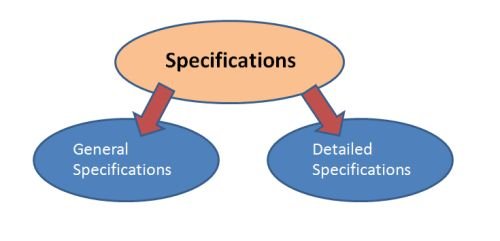What are Specifications?
Specifications describe the nature and the class of the work, materials to be used in the work, workmanship etc. and is very important for the execution of the work. The cost of a work depends much on the specifications. Specifications should be clear.

Purpose of giving Specifications
- The cost of an unit quantity of work is governed by its specifications.
- Specification of a work is required to describe the quality and quantity of different materials required for a construction work and is one of the essential contract documents.
- This also specifies the workmanship and the method of doing the work. Thus specification of a work serves as a guide to a supervising staff of a contractor as well as to the owner to execute the work to their satisfaction.
- A work is carried out according to its specification and the contractor is paid for the same. Any change in specification changes the tendered rate.
- As the rate of work is based on the specification, a contractor can calculate the rates of various items of works in tender with his procurement rates of materials and labour. Thus tender rate without specification of works is baseless, incomplete and invalid.
- Specification is necessary to specify the equipment tools and plants to be engaged for a work and thus enables to procure them beforehand.
- The necessity of specification is to verify and check the strength of materials for a work involved in a project.
Types of Specifications
- General Specifications
- Detailed Specifications
General Specifications
In general specifications, nature and class of works and names of materials that should be used are described. Only a brief description of each and every item is given. It is useful for estimating the project. The general specifications do not form a part of contract document.
Detailed Specifications
The detailed specifications form a part of a contract document. They specify the qualities, quantities and proportions of materials and the method of preparation and execution for a particular item of works in a project. The detailed specifications of the different items of the work are prepared separately and they describe what the work should be and how they shall be executed. While writing the detailed specifications, the same order sequence as the work is to be carried out is to be maintained.
I will discuss some of the important topics regarding Specifications of different material construction techniques:
RCC (reinforced Cement Concrete) Specifications
Specifications for Brick masonry in Cement Mortar
Specifications for Coursed Rubble Stone (CRS) Masonry
Specifications for Plain Cement Concrete (PCC)
was useful as i am a engg student and i have a test on this topic tomorrow…..
.saves time
.enables proper selection of suppliers
.obtain quality items and materials for a specified job
hi,
it is a very nice website.
i would like to know the amount of material requirment in all types of plain cement concrete.
(1:1.5:3 / 1:2:4 / 1:3:6 / etc)
this is a very good write up but i want to ask ”what are the functions of specification”
Higher good quality only on moderst complaint 1 case was cracked
when they arrived. Coin was nevertheless in excellent condition. I’ll deal with you
badasses once again.
Hi any civil engineer can I help me. I am student of civil technology. Please